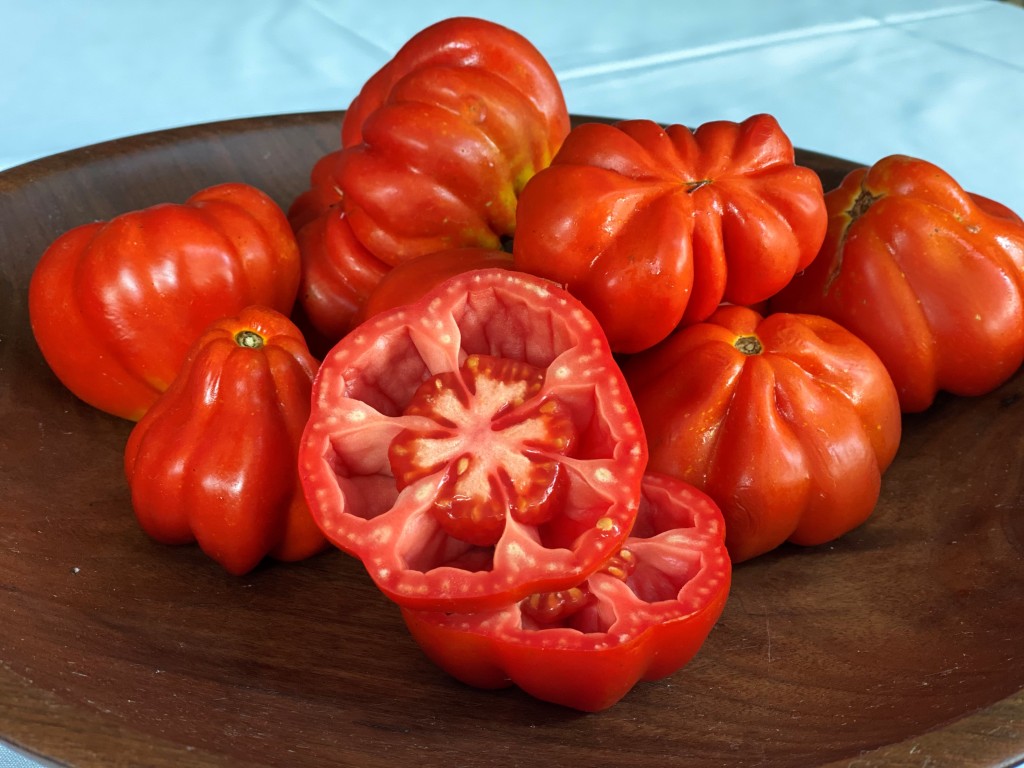
The Short Form: This is the perfect sauce (fresh or jarred) tomato
The Name: Canestrino means “little basket” in Italian. “di Lucca” is from the Lucca province of Tuscany. These puckered-top tomatoes can be stood up on their ends like baskets. Although they are considered thin-skinned, they stack nicely for transport.
Making Sauce: This variety has the driest flesh of any tomato I’ve ever grown (and as the proud owner of an Excalibur dehydrator, I’ve put many tomato types through it). Scoop out the center packet of seed, whirl in the food processor, dump in the stock pot – and don’t leave it on the stove too long because it forms sauce FAST! There just isn’t much excess water to boil off.
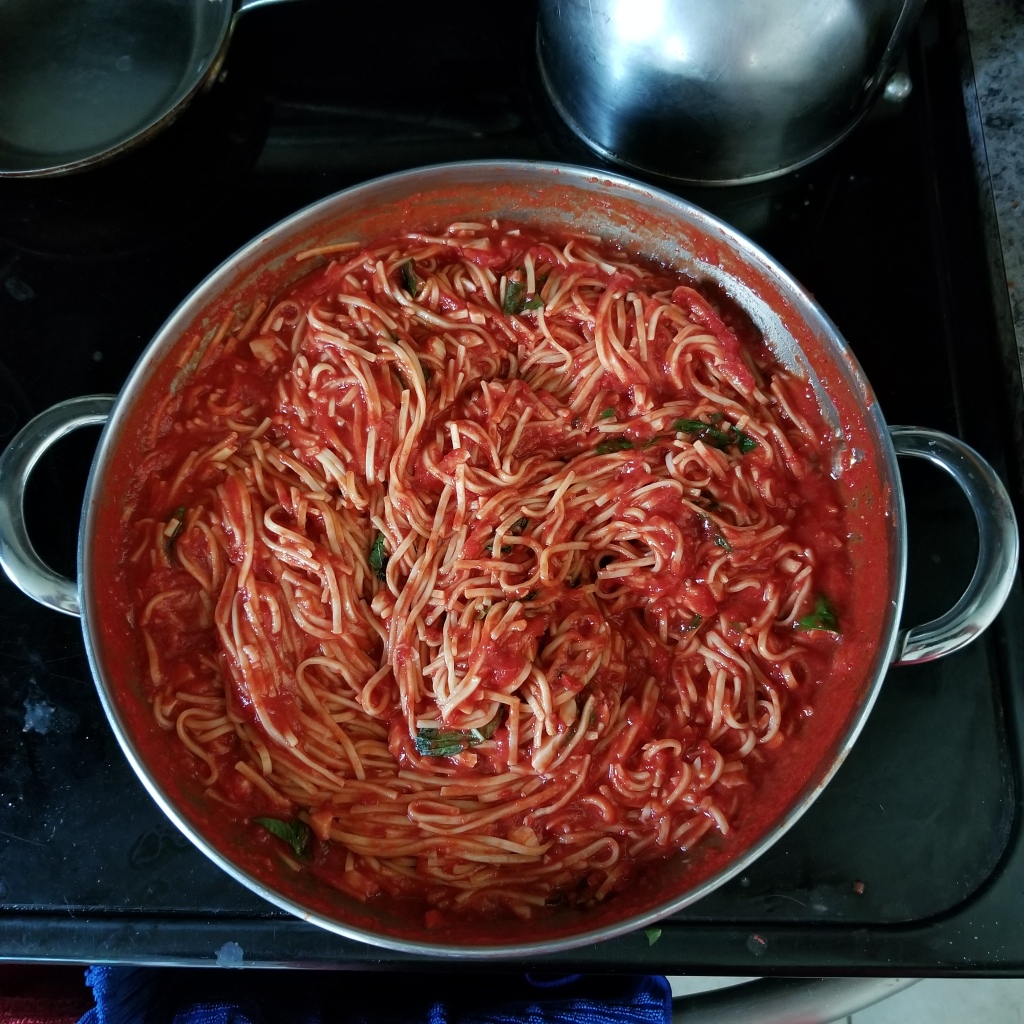
The first time I made fresh sauce, I saved the seeds, zipped in the food processor, brought the puree to a boil in the pan, tossed in a pound of dry spaghetti – and there was dinner in under 15 minutes. Gorgeous deep red color and flavor to match. It’s now my go-to for fresh sauce when I’m saving seed.
Several of my Phoenixville Farmer’s Market patrons bought these tomatoes for their dehydrators and were thrilled with the results. Canestrino reviews mostly rave about making sauce, but if you love dried tomatoes, they are worth trying.
A Perfect Tomato’s Imperfections: Green shoulders. Canestrino, like many from-Italy sauce tomatoes, has them. From the Slow Food Foundation:
“The Canestrino can also be recognized by the green color at the top of the fruit, which remains even when fully ripe, and the small clefts just underneath where the stem is attached. These esthetic imperfections serve as a kind of trademark for the Canestrino.”
The clefts aren’t always noticeable, but “the green color at the top of the fruit” is almost always there – unless the tomato in question is starting to rot. About ¼ of a given picking will be just right– the rest will have a bit too much green (give them no more than a day or so before use!) or are beginning to slide into rot.
True aficionados (especially those with Italian sauce tomato experience) will simply slice off those green shoulders (which are extremely common in from-Italy sauce tomatoes) or that bit of rot at the stem end and keep on making sauce. Those who expect perfect produce and/or haven’t made sauce before may need a gentle reminder about Italian sauce standards: flavor above all else and the bonus of flavor without endless simmering with Canestrinos.

Growing Conditions: Mid-season (75 days from transplant), regular leaf, indeterminate, 8 oz red paste tomatoes often with green shoulders.
As the photo shows, this is a plant that benefits from support (We use the Florida Weave) Growth rate is average for a paste tomato; plants are indeterminate, but not unruly. Fruits ripen in stages (the better for making sauce) and in theory, being indeterminate, plants should bear until frost. From the Slow Food Foundation:
“The fruits are harvested in stages, from the end of May all the way through to late autumn.”
In Tuscany, perhaps. In Southeastern Pennsylvania, not yet! My plants did NOT like cool to cold weather, especially cool nights. They went into stasis from mid-September (2020) to the killing frost in mid-October. Plants remained green with some flowers, but bore few ripe fruits until the vines gave up at the killing frost. I cut off sales in September and saved seed from the fruits that did ripen to broaden the variety’s fall range. Time will tell if this succeeds.
Field vs. High Tunnel: Followers of this blog know that I’m always trying out heirlooms in the high tunnel to see which ones will succeed. Sauce tomatoes don’t seem cost-effective to me for the high tunnel, so I’ll be keeping this variety in the field. I would expect that Canestrinos would appreciate the moderated temperatures in September/October, but I don’t have the space to fill expected orders. While I’ve handed out individual tomatoes for customers to try, my smallest orders have been 10 pounds and usual orders are 25 pounds. I’ll be expanding their area in the field and do my best to avoid a waiting list for the future. (Yes, a waiting list for sauce tomatoes – if a sauce maker tried these tomatoes, they wanted ALL their future sauce to be from Canestrinos!)
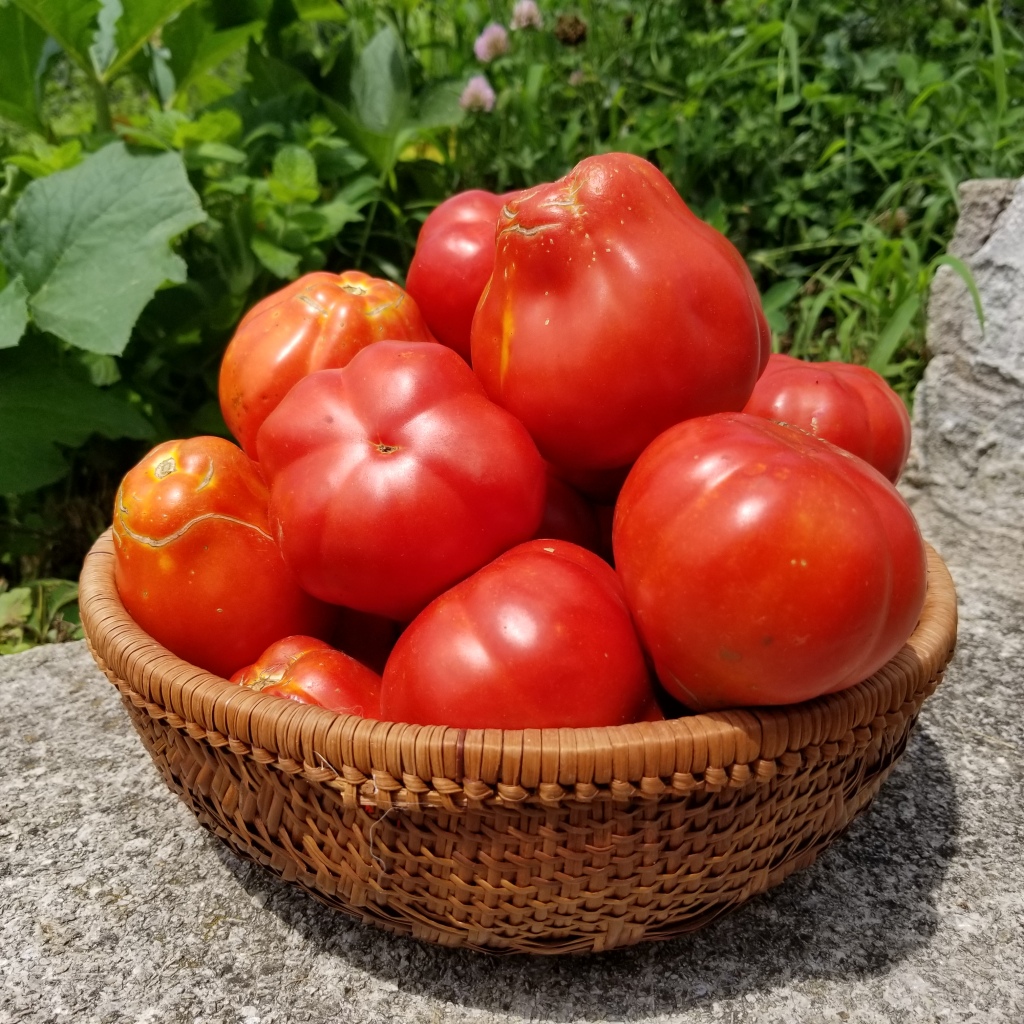
Slow Food’s Register of Biodiversity: In 2015, Italy placed the ‘Canestrino di Lucca’ tomato in its Presidi Slow Food/Register of Biodiversity for the Tuscan region not only to preserve the variety, but to promote its use.
The Italians are right! If sauce tomatoes are part of your produce offering, you should be growing this tomato – and saving the seeds to help it adapt to regions that aren’t Tuscany.
If you’d like to grow this tomato, you can get seeds here. Canestrino di Lucca Tomato – Truelove Seeds

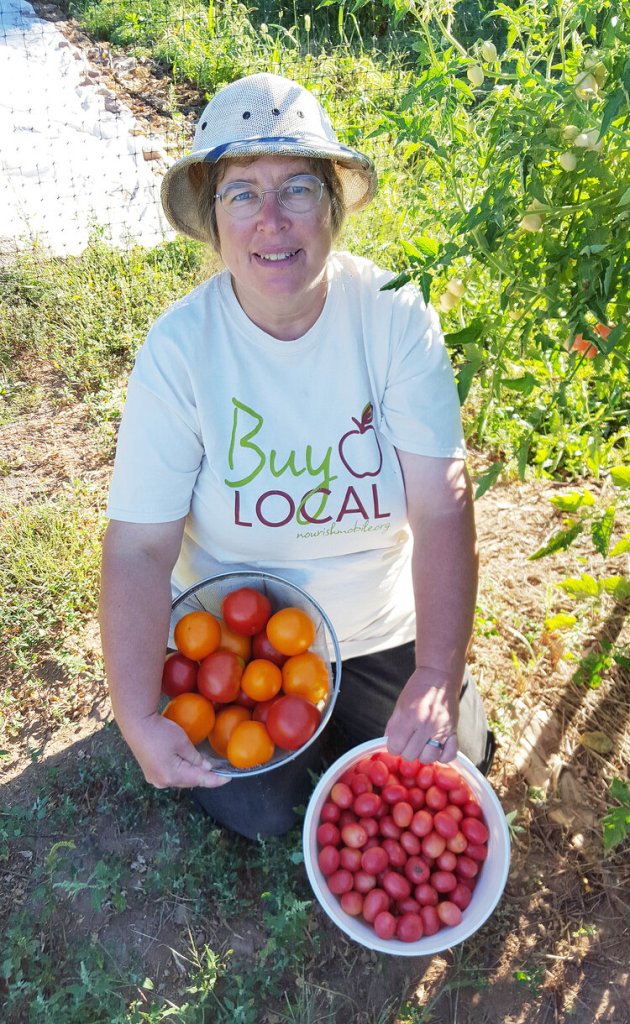
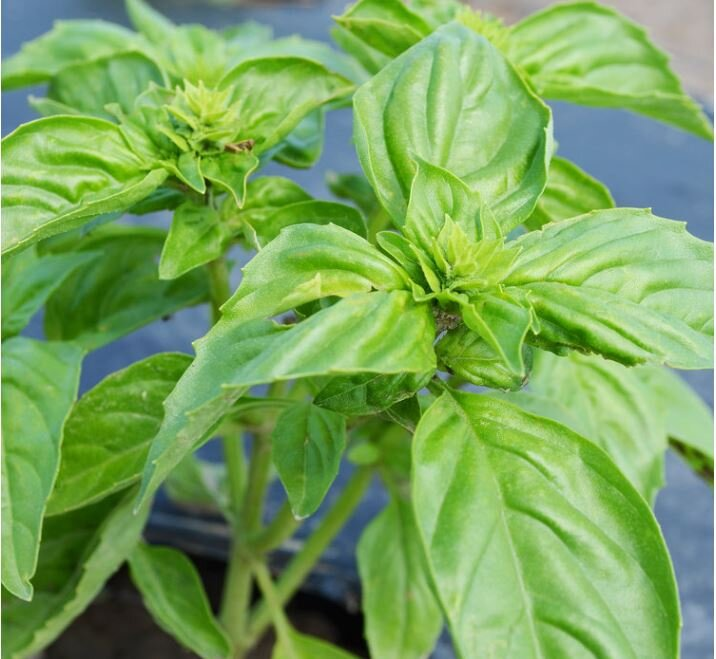
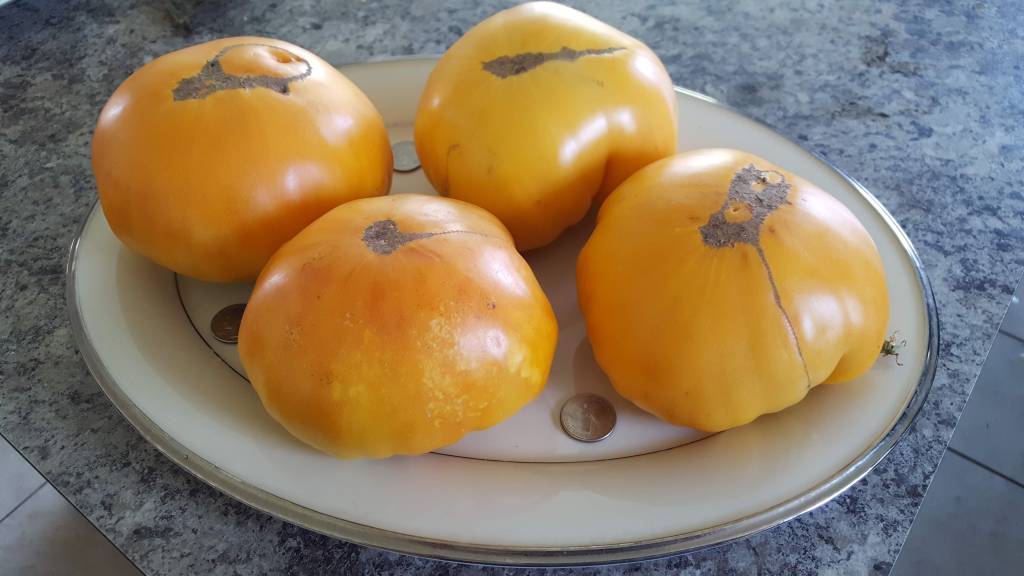
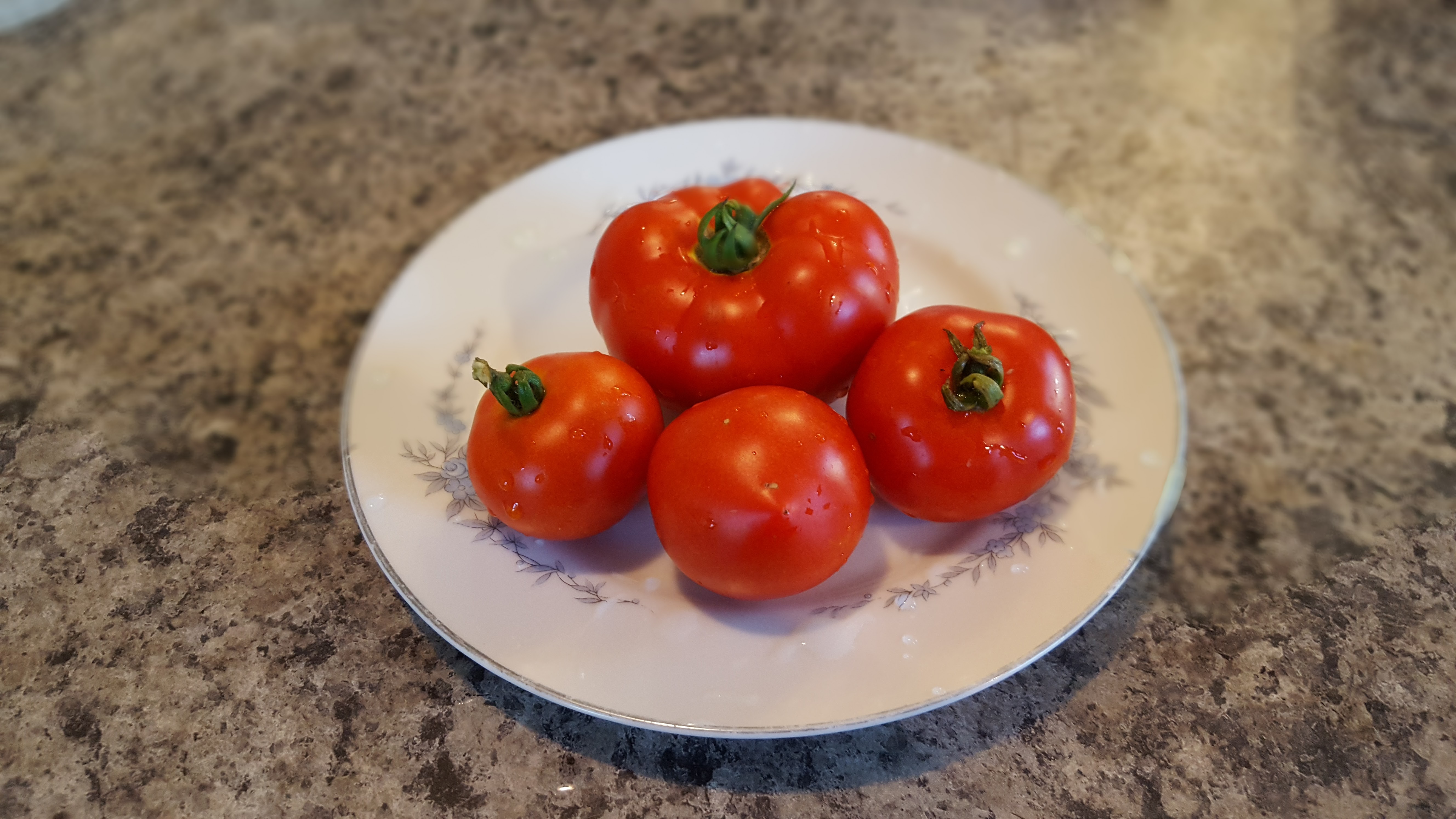








![close%20up%20PPP[1].jpg](https://hillcreekfarmpa.files.wordpress.com/2017/07/close20up20ppp13.jpg)
![many%20ppp[1].jpg](https://hillcreekfarmpa.files.wordpress.com/2017/07/many20ppp1.jpg)
![table%20ppp[1].jpg](https://hillcreekfarmpa.files.wordpress.com/2017/07/table20ppp1.jpg)
![Old%20Large%20Red%20Tomatoes[1].jpg](https://hillcreekfarmpa.files.wordpress.com/2017/07/old20large20red20tomatoes11.jpg)
![tomatoes%20and%20garlic[1].jpg](https://hillcreekfarmpa.files.wordpress.com/2017/07/tomatoes20and20garlic1.jpg)







![pearl%20bush%20Apr2016[1].jpg](https://hillcreekfarmpa.files.wordpress.com/2017/07/pearl20bush20apr20161.jpg)
![1st%20harvest%20asparagus%20processed[1].jpg](https://hillcreekfarmpa.files.wordpress.com/2017/07/1st20harvest20asparagus20processed1.jpg)
![Asparagus%20harvesting%20equipment%20April%202015[1].jpg](https://hillcreekfarmpa.files.wordpress.com/2017/07/asparagus20harvesting20equipment20april2020151.jpg)
![1st%20asparagus%20harvest%20basket[1].jpg](https://hillcreekfarmpa.files.wordpress.com/2017/07/1st20asparagus20harvest20basket1.jpg)
![1st%20harvest%20Purple%20Passion[1].jpg](https://hillcreekfarmpa.files.wordpress.com/2017/07/1st20harvest20purple20passion1.jpg)
![magnolia%20April%202015[1].jpg](https://hillcreekfarmpa.files.wordpress.com/2017/07/magnolia20april2020151.jpg)